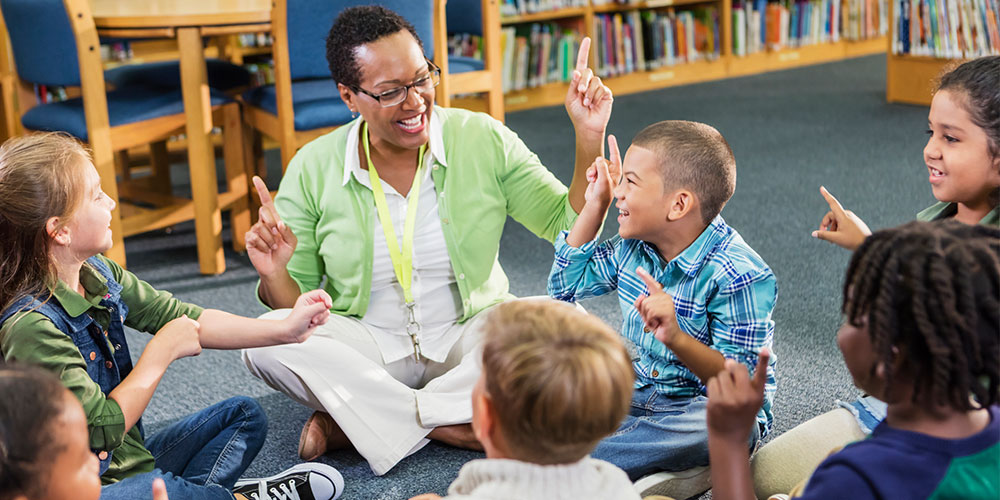While driving my five-year-old grandson home from a birthday party, I asked him, “What was your favorite part of Aniyah’s birthday party?” His response: “My favorite part of Aniyah’s birthday party was playing in the bounce house.” That, my friends, is a very complete and comprehensive response!
One might think that he must be advanced for his age. Nope—he’s in a state public preschool with an IEP for developmental delays and speech impairment. So how is he so articulate? He attends a school that recognizes that oral communication is an important part of literacy and a skill they want to emphasize at every level, not just pre-k.
Your Kids Don’t Know How to Speak
Early in my principalship, I attended a two-day workshop with Ellin Keene, a published author, staff developer, researcher, and presenter. She was demonstrating literacy strategies with a group of students from our school district. After her demonstration, she proclaimed that our students did not know how to speak. Keep in mind, we were the number one school district in the state, and she had the audacity to tell us that our kids couldn’t speak!
Since that fateful day, I learned that literacy involves more than reading and writing. Being literate includes listening carefully and speaking clearly. That means we need to teach our students speaking and listening, explicitly, at every grade level.
The Art of Listening
As my teachers and I ventured down this new path of literacy instruction, we began to focus on teaching students to listen. As adults, we understand the importance of looking at the speaker, making eye contact, and using nonverbal language to indicate we are listening (e.g., nodding, open body language). But how often do you teach that skill to your students? Especially at the middle and high school levels, schools often neglect explicit listening instruction, as it is simply not at the top of their priority list.
Teaching students to listen involves the same elements of any other instructional best practice:
- Setting: The classroom must be set up to accommodate the activity you want to teach. So in this case, students need to sit in a circle to see each other’s faces. Students can sit on the floor, or they can move chairs and desks into a circle.
- Modeling: You should join your students in the circle and explicitly model how you want them to behave. Not only should you model what good listening looks like, but you should also show what bad listening looks like (talking to your neighbor, body turned away from speaker, etc.).
- Explicit explanation: Ask students to share their thoughts on why listening is important. After they’ve open the dialogue, you can discuss the benefits of listening and the consequences of not listening. Be sure to help students make real-world connections, especially when it comes to being a productive future citizen. This is particularly important for older students as they draw closer to leaving formal instruction.
Speaking in Complete Sentences
Too many teachers, myself included, are satisfied with one- or two-word responses from our students. We ask a question, and we accept the response, no matter how curt. How many continents are there? Seven. What was one cause of the Revolutionary War? Taxation without representation. Who developed the theory of relativity? Einstein. And, as adults, we respond in the same way.
To be well spoken, students (and adults) need to learn how to speak in complete sentences, which means responding to questions in complete sentences. Teachers are invaluable in holding students accountable to learn this skill. Accountability involves:
- Modeling: When a student asks you a question, make sure to respond in complete sentences yourself!
- Practicing: As with listening, it’s helpful to set aside short pockets of time for students to practice answering in full sentences.
- Correcting: If students give a one- or two-word response, ask them to respond in a complete sentence.
As a principal, I conducted observations for 45 teachers. It was clear which ones emphasized speaking in complete sentences and which did not. Just like with my grandson, I saw 5-year-olds respond to their teacher by name and in complete sentences. Eleven- and 12-year-old students modeled the same behaviors, not because they remembered from kindergarten but because their intermediate teachers held them accountable to speak clearly and concisely.
As students get older, oral communication becomes increasingly important because they tend to absorb themselves in social media communications and are more peer oriented. Even if your middle and high school students have learned good oral communication in the past, it’s essential to continue modeling, explaining, and holding them accountable to practice it.
Teacher as Facilitator
When the teacher does most or all of the talking, communication is one way and listening decreases. As you focus on teaching listening and speaking skills, it’s important that you take the role of facilitator. Let the students do the talking while you provide prompts and guiding questions that will lead them to understanding.
Here are some prompts you might use:
- How can you show you are a good listener?
- How can you show the speaker that you are listening and that you heard what he or she said?
- Why is it important to be a good listener?
- Why is it important to be a good speaker?
- How does speaking in complete sentences help you be a good communicator?
- Why is good communication important? What advantages will it give you in the future?
Even a Five-Year-Old Can Do It!
We all know the importance of reading, writing, math, history, and the sciences. Strong oral communication skills are just as crucial, and will help set up students for lifelong success. Be intentional, model, and hold students accountable for being good listeners and speakers. Even a five-year-old can do it.






